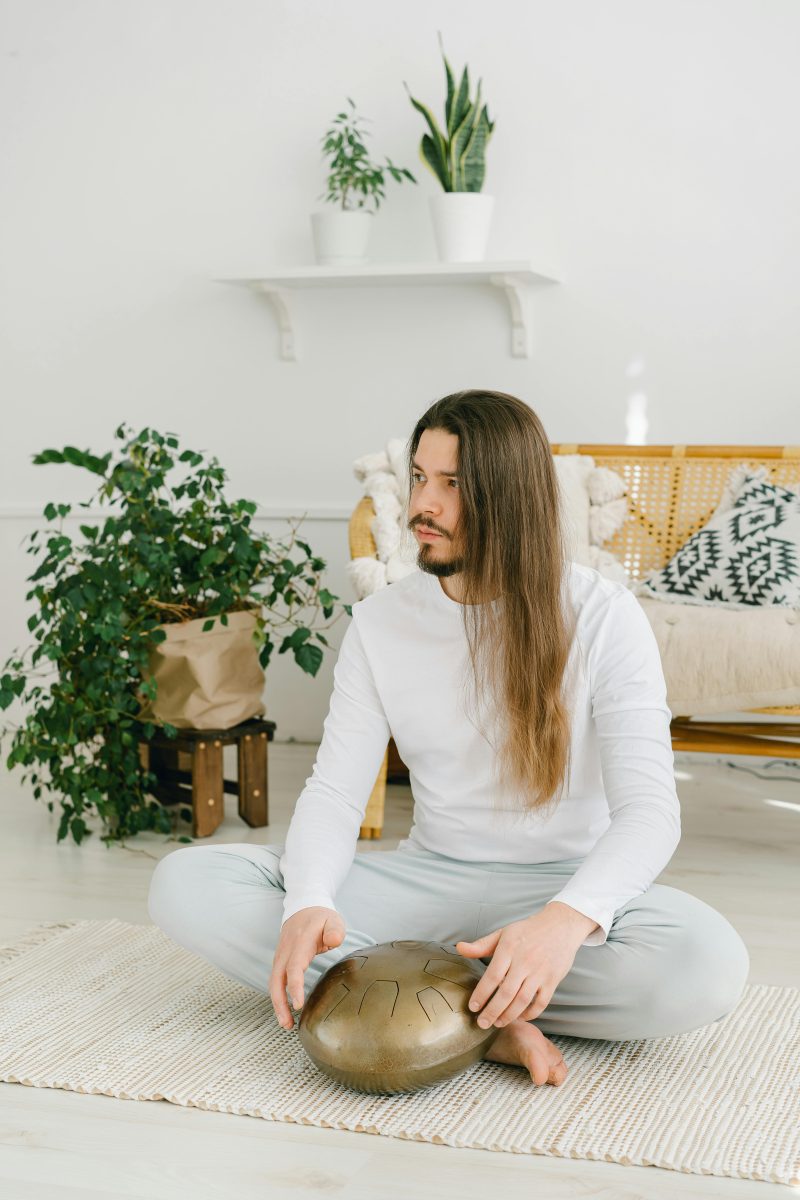Last Updated on: 14th July 2024, 10:55 am
Introduction to Yoga as a Therapeutic Tool

Yoga, an ancient practice rooted in over 5,000 years of Indian philosophy, has evolved into a modern wellness phenomenon. Initially a spiritual and ascetic discipline, it has transformed. Today, it’s a global symbol of a holistic approach to health, intertwining the mental, physical, and spiritual realms. This evolution has positioned yoga as a powerful therapeutic tool, especially in the realm of mental health.
At its core, yoga offers more than just physical postures; it’s a comprehensive lifestyle practice. It integrates breathing techniques, meditation, and ethical principles, aiming to harmonize the body and mind. This holistic approach is what makes yoga uniquely effective in managing and alleviating symptoms of anxiety and depression. By fostering a deep connection between physical movement and mental clarity, yoga encourages a state of mindfulness and present-moment awareness, crucial for mental well-being.
As we delve deeper into how yoga can aid in combating anxiety and depression, it’s essential to recognize its rich history and the multifaceted approach it offers towards achieving mental and physical health. The beauty of yoga lies in its adaptability and accessibility, making it a valuable tool for anyone looking to enhance their quality of life.
Understanding Anxiety and Depression

Definitions and Distinctions
Anxiety and depression, while often mentioned in the same breath, are distinct mental health conditions. Anxiety is characterized by excessive worry and fear, a state of heightened alertness that can be debilitating. Depression, on the other hand, is marked by a persistent feeling of sadness or loss of interest, leading to a range of emotional and physical problems. Despite their differences, both conditions can severely impact an individual’s ability to function daily.
Common Symptoms and Traditional Treatments
- Anxiety: restlessness, increased heart rate, difficulty concentrating.
- Depression: lack of energy, changes in appetite, feelings of worthlessness.
Traditional treatments for these conditions typically involve medication, psychotherapy, or a combination of both. These methods aim to manage symptoms and improve quality of life.
The Growing Need for Alternative and Complementary Therapies
As awareness of mental health increases, so does the pursuit of alternative and complementary therapies. Many individuals seek treatments that go beyond traditional methods, looking for holistic approaches to wellness. This shift reflects a growing understanding that mental health is multifaceted, requiring a comprehensive approach to care. It’s within this context that yoga emerges as a promising option, offering a natural and accessible way to enhance mental well-being.
Yoga, with its emphasis on mindfulness, breathing, and physical movement, aligns perfectly with the need for therapies that address both the mind and body. Its practice promotes relaxation, improves mood, and fosters a sense of inner peace, making it an effective complementary therapy for those experiencing anxiety and depression. By integrating yoga into their wellness routine, individuals can explore a path to healing that is both empowering and transformative.
The Science Behind Yoga and Mental Health

Overview of Scientific Research on Yoga’s Impact on the Brain
Recent studies illuminate yoga’s profound effect on the brain, revealing how this ancient practice enhances mental health. Research demonstrates that regular yoga practice can lead to significant improvements in areas critical for mood regulation, stress response, and overall brain function. These findings underscore yoga’s potential as a powerful tool in managing anxiety and depression.
How Yoga Affects Neurotransmitters Related to Mood Regulation
At the heart of yoga’s benefits are its effects on neurotransmitters, the brain’s chemical messengers. Yoga increases the production of serotonin and gamma-aminobutyric acid (GABA), both crucial for mood balance and anxiety reduction. This elevation in neurotransmitters can lead to a more stable mood and a sense of calm, offering relief to those battling anxiety and depression.
The Role of Yoga in Stress Response Modulation
Yoga’s ability to modulate the body’s stress response is another key to its mental health benefits. Through practices like deep breathing and mindfulness, yoga reduces levels of cortisol, the stress hormone. This reduction in cortisol can diminish the physical and psychological impacts of stress, promoting relaxation and reducing symptoms of anxiety and depression. The practice encourages a state of relaxation, shifting the balance from the sympathetic nervous system (responsible for the ‘fight or flight’ response) to the parasympathetic nervous system, which governs rest and digestion. This shift can lead to a profound sense of calm and well-being.
Integrating yoga into one’s life offers a holistic approach to managing mental health, providing a natural and effective way to enhance well-being. Its benefits extend beyond the physical, touching the depths of the mind, and offering a sanctuary of peace in a turbulent world. As more individuals turn to yoga, its role in mental health continues to gain recognition, promising a path to healing that is both ancient and profoundly relevant today.
Key Yoga Practices for Managing Anxiety and Depression

Breathing Techniques (Pranayama)
At the heart of yoga’s therapeutic power are its breathing techniques, known as Pranayama. These practices are not just about taking deep breaths; they’re about controlling the breath to influence the nervous system. By focusing on slow, controlled breathing, we can calm the mind, reduce stress, and alleviate anxiety. This shift in focus and breathing pattern activates the parasympathetic nervous system, promoting relaxation and a sense of peace.
Specific Yoga Poses (Asanas)
Yoga offers a variety of poses designed to release tension, improve circulation, and enhance mood. Poses like Child’s Pose (Balasana) and Downward-Facing Dog (Adho Mukha Svanasana) are particularly beneficial for those struggling with anxiety and depression. These asanas encourage deep breathing, focus, and a physical release that together combat stress and lift spirits. By engaging in these poses regularly, individuals can experience a significant reduction in symptoms of anxiety and depression.
Meditation and Mindfulness Practices
Integrating meditation and mindfulness with yoga creates a powerful combination for mental clarity and peace. Meditation encourages a state of present-moment awareness, helping to clear the mind of clutter and reduce rumination, a common issue in anxiety and depression. Mindfulness, on the other hand, teaches us to observe our thoughts and feelings without judgment, fostering a compassionate relationship with ourselves. Together, these practices enhance the mental health benefits of yoga, leading to greater emotional balance and well-being.
Yoga, with its holistic approach to wellness, offers a natural and empowering path to managing anxiety and depression. Through the practices of Pranayama, specific asanas, and mindfulness, individuals can find a sense of calm and clarity amidst the chaos of life. Embracing yoga as part of a daily routine can transform the journey towards mental health, making it a journey of healing, discovery, and peace.
Personal Stories of Transformation

Across the globe, individuals have turned to yoga as a beacon of hope in their battles with anxiety and depression. Their stories, diverse yet unified in theme, highlight yoga’s transformative power on mental health and overall quality of life.
One such story is of Alex, who found solace in yoga during a particularly dark period of depression. Initially skeptical, Alex began practicing yoga as a last resort. Over time, the combination of movement, breathwork, and meditation offered a new perspective on life. Alex credits yoga with not just alleviating symptoms of depression but also with instilling a newfound sense of peace and self-acceptance.
Similarly, Jordan’s journey with anxiety showcases the multifaceted benefits of yoga. Plagued by chronic anxiety and panic attacks, Jordan discovered yoga through a friend’s recommendation. The practice of mindful breathing and focused asanas (poses) became a daily ritual, transforming anxiety into a manageable aspect of life. Jordan emphasizes how yoga has not only reduced anxiety but also improved sleep quality and overall physical health.
Then there’s Kim, who combines yoga with outdoor activities to combat her anxiety. For Kim, yoga is more than just a practice; it’s a lifestyle that encourages connection with nature, enhancing her mental and physical well-being. The integration of yoga into her hiking and cycling routines has provided a holistic approach to managing anxiety, proving the adaptability of yoga to fit individual needs and preferences.
These stories, among countless others, illustrate the profound impact yoga can have on mental health. By fostering a deep connection between body and mind, yoga offers a path to healing that is both ancient and profoundly relevant. It’s a testament to the power of this timeless practice in transforming lives, one breath at a time.
Implementing Yoga into Your Daily Routine

Practical Tips for Beginners
- Start with shorter sessions, perhaps 10-15 minutes, and gradually increase as you become more comfortable.
- Prioritize regularity over duration; it’s better to practice a little each day than to do a lot sporadically.
- Focus on mastering the basics before moving on to more complex poses.
- Always listen to your body, respecting its limits.
Creating a Conducive Environment at Home
- Designate a tranquil space for your practice, free from distractions.
- A clean, airy room or a quiet corner with enough space to move freely is ideal.
- Consider adding elements that promote serenity, such as plants, soft lighting, or calming music.
- Ensure your yoga mat is comfortable and supportive, and keep props like blocks or a strap handy to aid your practice.
Finding the Right Yoga Style and Instructor
- Yoga comes in many forms, from the gentle flow of Hatha to the vigorous sequences of Vinyasa.
- Explore different styles to find what resonates with you.
- When seeking an instructor, look for someone certified, with a teaching style that you find encouraging and approachable.
- Online platforms offer a wealth of resources, allowing you to practice with experienced instructors from the comfort of your home.
Integrating yoga into your daily life can be a seamless process. With the right approach, environment, and guidance, you’ll soon discover the profound benefits that this ancient practice can bring to your mental and physical health. Embrace the journey, and let yoga be your guide to a more balanced and peaceful existence.
Overcoming Challenges and Common Misconceptions

Addressing Common Barriers
- Starting a yoga practice can seem daunting. Many believe they lack the flexibility, strength, or calmness it seemingly requires.
- Yet, the essence of yoga is not about achieving perfect poses but about embarking on a journey of self-discovery and improvement.
- It’s about progress, not perfection. By starting with basic poses and gradually expanding your practice, yoga becomes accessible to everyone, regardless of their starting point.
Debunking Myths About Accessibility
- One pervasive myth is that yoga is only for certain body types or age groups. This couldn’t be further from the truth.
- Yoga is adaptable and can be modified to suit anyone’s needs. Specialized classes, such as chair yoga for those with mobility issues or gentle yoga for seniors, make it inclusive.
- The key is finding the right style and instructor to guide you on your journey.
- Another common misconception is that yoga requires expensive gear or studio memberships. In reality, all you need is a small space and a mat.
- With countless free online resources, yoga has never been more accessible. It’s a practice that can be done anywhere, from the comfort of your home to a quiet spot in nature.
Encouragement for Patience and Persistence
- Embarking on the path toward mental wellness through yoga requires patience and persistence.
- Progress may be slow, and there will be challenges along the way. However, the benefits of a consistent practice are profound.
- Over time, yoga not only enhances physical flexibility and strength but also promotes mental clarity, resilience, and a deep sense of peace.
- It’s a journey worth taking, one breath at a time.
Remember, yoga is not a quick fix but a lifelong practice. Celebrate the small victories, like feeling a little more relaxed after a session or noticing a slight improvement in your flexibility. These moments of progress are stepping stones on the path to well-being. With patience and persistence, yoga can be a powerful tool in managing anxiety and depression, transforming challenges into opportunities for growth.
Let yoga be your companion on the journey toward mental wellness. Embrace its teachings with an open heart and mind, and discover the transformative power of this ancient practice. The path may not always be easy, but the rewards of a more peaceful and balanced life are within reach.
In Closing
Yoga transforms lives, one breath at a time. It offers a sanctuary of peace in a turbulent world, bridging the gap between physical health and mental well-being. Through its practices, yoga navigates the delicate balance between the challenges of anxiety and depression and the profound rewards of resilience and joy. It empowers individuals to embark on a journey of self-discovery, healing, and transformation, underscored by personal stories of triumph and the practical steps toward integrating yoga into daily life. Let this ancient practice be your guide to a more balanced, peaceful existence, inviting you to explore its depths and embrace its potential for transformative growth.
How Yoga Can Help with Anxiety and Depression FAQs
The risks associated with using yoga to manage anxiety and depression are minimal, especially when practiced under the guidance of a qualified instructor. It’s important to listen to your body and avoid poses or practices that cause discomfort or pain. Individuals with certain health conditions should consult a healthcare provider before beginning a yoga practice.
Beginners can absolutely experience benefits from yoga for anxiety and depression, as the practice is inclusive and adaptable to all skill levels. Starting with basic poses and gradually increasing complexity can help build a foundation of mindfulness and stress relief. The key is regular practice and focusing on the connection between mind, body, and breath.
Yes, yoga can significantly help reduce symptoms of anxiety and depression. It promotes relaxation and stress reduction, which can alleviate symptoms of anxiety. Additionally, the practice encourages mindfulness, which helps in managing depressive thoughts.
Yoga can be a complementary practice to traditional therapy and medication but should not replace them without consulting a healthcare provider. It can enhance the effectiveness of traditional treatments by promoting relaxation and mindfulness. However, severe cases of anxiety and depression may require more intensive therapy and medication.
The effectiveness of yoga for anxiety and depression is not solely dependent on the length of the session but more on the consistency and mindfulness of the practice. Even short, daily sessions can be beneficial if practiced regularly. However, longer sessions may provide a deeper level of relaxation and a more profound mental health benefit.
Yoga affects the brain by increasing the production of serotonin and reducing levels of cortisol, which can help improve mood and reduce stress. The practice also enhances brain function and neural connectivity, leading to improved emotional regulation and a decrease in symptoms of anxiety and depression.
Yoga is unique in its holistic approach, addressing both the mind and body, making it particularly effective for managing anxiety and depression. Unlike many forms of exercise that focus primarily on physical activity, yoga incorporates mindfulness, breathing exercises, and meditation, which can directly impact mental health. This comprehensive approach can offer more profound and lasting benefits for those struggling with anxiety and depression.
Practicing yoga regularly, at least 2-3 times a week, can help you see benefits for anxiety and depression. Consistency is key to experiencing the therapeutic effects, including stress reduction and improved mood. Over time, regular practice can lead to significant improvements in overall mental health.
While any form of yoga can be beneficial, Hatha yoga and Restorative yoga are particularly effective for anxiety and depression. Hatha yoga focuses on physical postures and breathing exercises that promote relaxation and mental clarity. Restorative yoga involves gentle poses supported by props to relax the body deeply and calm the mind.
The immediate effects of yoga on anxiety and depression include a sense of calm, reduced stress levels, and improved mood. Practicing yoga can lead to a decrease in physical tension and an increase in feelings of peace and well-being. These effects can be felt directly after a yoga session and contribute to long-term mental health benefits with regular practice.
Orlando is a all round athlete from Australia, now resident in Germany. His sports of passion of American Football(Offensive line), weight training and indoor rock climbing where he uses his 195cm wing span to his advantage.



